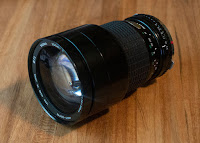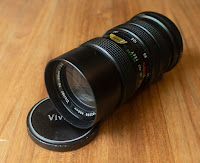Cost: $19.99 (average market price $20)
It's pretty top-heavy lens, with a huge large front lens element, but well made. Looks are a little off, so difficult to give an opinion on. Just a matter of taste, if you ask me. As most Sigma lenses of that period, zoom and focus is a little to loose, and makes a nasty bang when reaching the end of the range.
Image quality is OK, with rich colors, and reasonable sharpness for a old zoom. It's a slow lens though, so you loose quality when going indoor or in low light situations. There is also some vignetting present.
So, if you can find one cheap, it's a nice lens to take out if you can only take one lens and do not want to spend tons of money. But, if you are looking for the best quality, buy a few old prime lenses instead.
Lens Specification:
Focal Length: 28-200mm
Maximum Aperture: F4-5.6
Minimum Aperture: F22
F22 Image Format: 35mm
Lens Mount: OM
Optics: unknown
Blades: 6
Focussing: Manual
Minimum Focus: 250cm (100cm in Macro)
Filter Size: 72mm
Weight: 713g
Length: 114-164mm
Production: unknown
Serial Number: 1009544
Made in: Japan
More information on: Sigma Corporation
 |
| 1/160 sec - ISO500 - Handheld |
 |
| 1/400 sec - ISO100 - Handheld |
 |
| 1/640 sec - ISO100 - Handheld |
 |
| 1/160 sec - ISO100 - Handheld |
 |
| 1/160 sec - ISO6400 - Handheld |
 |
| 1/160 sec - ISO100 - Handheld |
Sources:
allphotolenses.com













































